Bitcoin is 14 years old, has been through many stress tests, and continues to mature each passing year. It emerged as a cyberpunk experiment, worth zero money, launched by a mysterious pseudonym called Satoshi Nakamoto, and has become the most appreciated asset of the last decade.
That’s right: Bitcoin appreciated 6 billion percent from 2009 to its peak in 2021 at $69,000, surpassing gold, stocks, and funds.
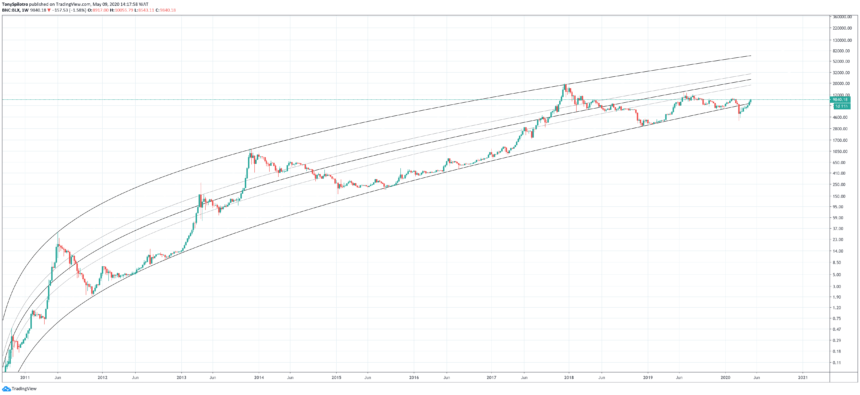
How high can the price of Bitcoin go?
Many believe that Bitcoin has already appreciated as much as it could and that it’s no longer possible to get rich with Bitcoin. Is that true? To try to predict the currency’s price in the coming years, various calculations and theories have been created, each with diverse interpretations.
It’s important to remember that Bitcoin was worth nothing when it was created; people didn’t yet fully understand what BTC was for. It was seen as an online game token and was dismissed in the same way some skeptics did when the internet and computers first appeared.
Bitcoin was created to decentralize money and the financial system. This is such a significant change from what exists today that everything Bitcoin has accomplished in these 14 years pales in comparison to the scale it could reach.
The process for Bitcoin to become a store of value, a safe haven against insecurity with intermediaries, banks, and against the monetary inflation of fiat currencies is slow and could last a century, as history shows.
The parabolic adoption of gold
Gold took a long time to be fully used as the main store of value in the past. 500 years before Christ, gold, silver, and bronze were considered money. But as the centuries passed, gold took the position of store of value due to its stronger monetary properties compared to other metals. Throughout this process, gold demonetized other forms of money and absorbed value, but this process took nearly 2,000 years.
Bitcoin is an improved digital version of gold, gradually tending to demonetize and absorb value from other currencies and assets with inferior properties or that will deteriorate over time through inflation.
In the long run, Bitcoin’s value today is extremely low compared to what it could achieve. Of course, none of this will happen without volatility. Volatility is precisely these market forces acting on adoption, and that’s normal.
Gold during the hyperinflation in Weimar was also extremely volatile, and that didn’t discredit it as a store of value at the time. In fact, it was merely reflecting the turbulence of the German economy during that period:
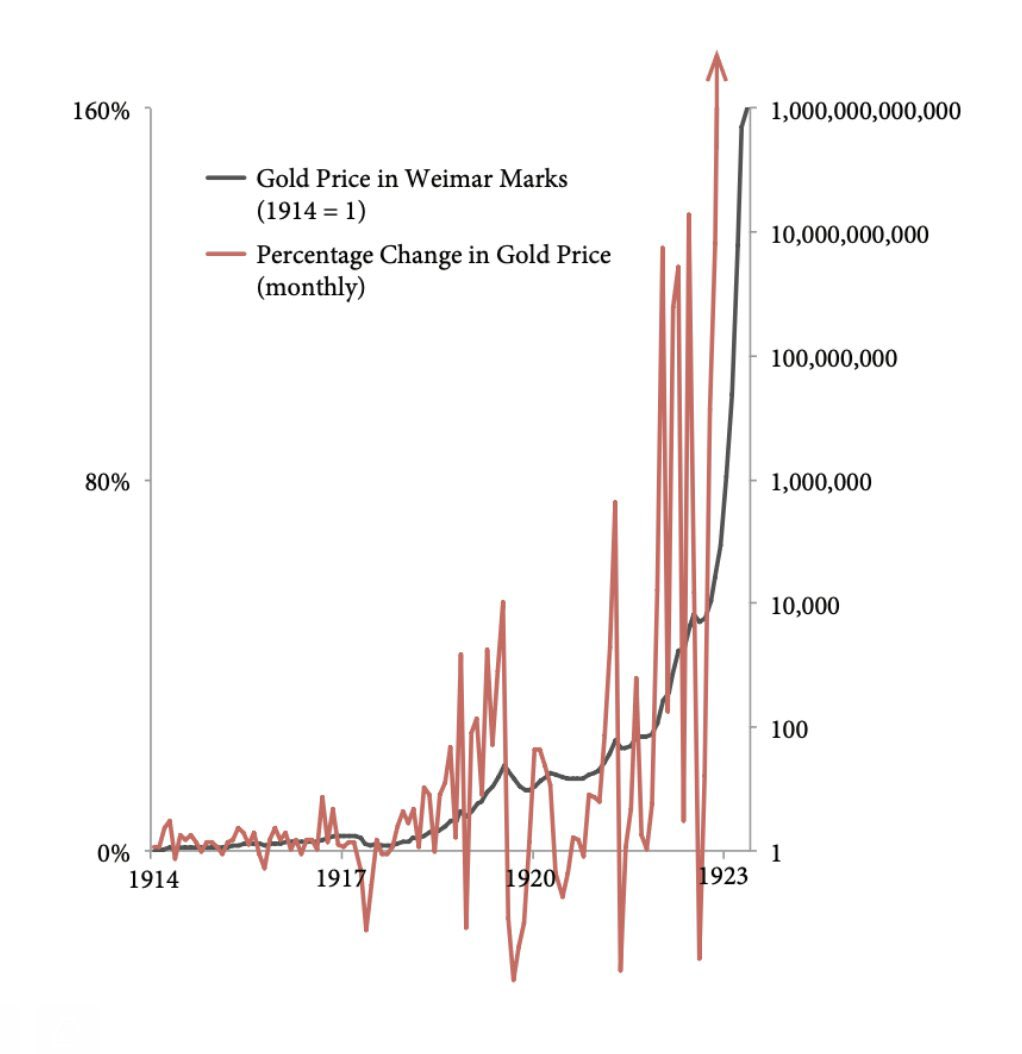
In 2008, gold fell 50%; in 2020, it also fell 50%, and it still remained a store of value. Central Banks continue to fill their vaults with gold because it is more reliable than government currencies.
Bitcoin is experiencing faster adoption than the internet or other technologies when they were at the same stage in their development, despite all the volatility and criticism from fiat currency and bank defenders. Bitcoin is likely to continue appreciating because it accelerates the Digital Revolution initiated by the internet, which digitized information.
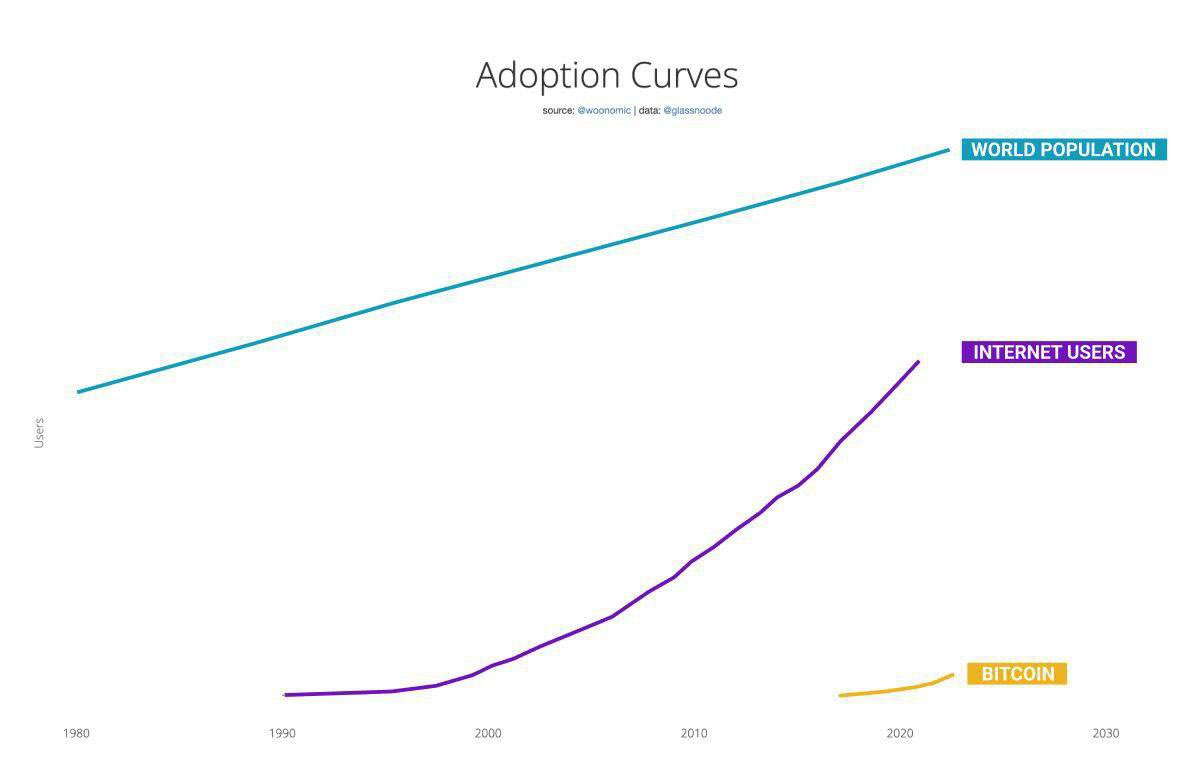
Bitcoin digitizes value, creates absolute scarcity, eliminates the need for Central Banks, and initiates an alternative and independent financial system. If it follows the adoption and monetization process of gold, for example, it is likely to appreciate even more.
One Bitcoin could be worth millions of dollars
With the increasing adoption of Bitcoin as a store of value and the potential scenarios of absorbing value from other currencies and assets, it’s possible that one Bitcoin could be worth millions of dollars in the future.
Let’s explore some calculations that have been created and show the potential that Bitcoin has to reach astronomical prices.
Calculation 1: $95.000 per Bitcoin
The current market capitalization of gold is about $10 trillion. In the short term, if Bitcoin becomes considered a store of value, it could take on a portion of the value that would go to gold. If it absorbs just 20% of gold’s value, that would give it a market cap of $2 trillion and about $95,000 per Bitcoin.
Calculation 2: $1.9 million per Bitcoin
However, if distrust in governments and the security of their bonds continues to grow, it’s likely that Bitcoin will absorb much of the value of government bonds, which are debt-backed securities. Today, the global debt is around $400 trillion in bonds, and Bitcoin could absorb some of that liquidity as insurance against the fiat system.
Greg Foss, an investor specializing in measuring credit default risk and monitoring credit default swaps, has been saying this for quite some time.
Bitcoin could quickly absorb 5, 10, or 20% of this value due to turbulence in the banking system and FUD about the fiat system. If it absorbed 10%, for example, it would bring Bitcoin’s market cap to $40 trillion and a value of $1.9 million per Bitcoin.
Calculation 3: $4.2 million per Bitcoin
But Bitcoin doesn’t need to only replace gold or bonds. It can absorb a bit from each asset class and even the value of existing debt in the world over time. If we combine all assets, debt, and currencies, there’s about $900 trillion in the world today. Only a portion of these assets is used as a store of value.
Once people start seeing Bitcoin as an asset uncorrelated with fiat assets, playing a significant role in portfolio balancing as an “anti-fiat insurance” against the uncertainties of the system, it will likely absorb more value. After all, central banks and governments constantly change interest rates, inflation targets, and print money; there is no predictability or security in monetary policies.
Imagine when investors realize that Bitcoin is a parallel economic system that doesn’t change its fundamental properties, is more predictable than fiat assets, and has a price that tends to keep growing because the incentives are directed towards that and can’t be changed?
That’s why, as Bitcoin matures, it could absorb 10% of the $900 trillion. This would result in a market capitalization of $90 trillion, representing a value of $4.2 million per Bitcoin.
Calculation 4: $5.3 million per Bitcoin
If we account for lost Bitcoins, which drives the price even higher because it becomes scarcer, $90 trillion divided by 17 million Bitcoin equals $5.3 million.
Today’s $30,000 Bitcoin price seems like nothing, a bargain, when we make these calculations. That’s why those who only look at the last all-time high price don’t realize that if Bitcoin reaches that level, it won’t make a difference whether someone bought $100 worth of Bitcoin once at $30,000 or $60,000. What matters is whether you kept accumulating and stored it securely to not lose your coins.
How to read the Bitcoin chart
Most of these theories analyzing Bitcoin don’t use the linear chart, which is the standard chart on exchanges or in traditional market analysis software.

We all know that Bitcoin is extremely volatile, making wide moves, and in a short period of time, it went from 0.1 cents to $20,000. Thus, it’s necessary to view it on a scale that represents these movements – the logarithmic scale.
On the logarithmic scale, the distance between numbers is equivalent to the same proportion, making it easier to observe and understand all the movements. Take a look at the difference between viewing the Bitcoin price on a linear scale and a logarithmic scale below:
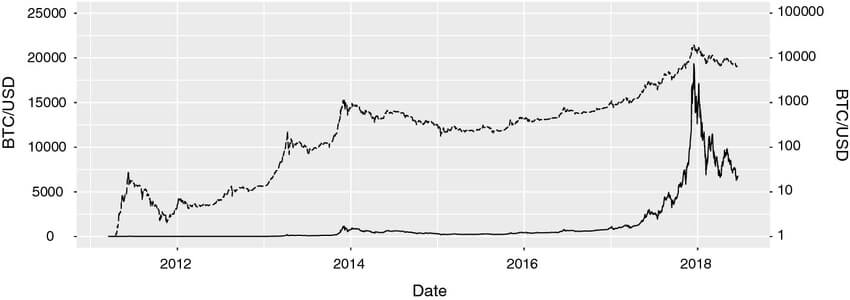
Therefore, it’s possible to extract much more information from the beginning of Bitcoin, when it was traded at a very low price, by using the logarithmic scale.
Appreciation Theories
In addition to the calculations shown earlier, which were made from simulations of Bitcoin absorbing part of the market capitalization of traditional assets, there are also famous theories that attempt to project Bitcoin’s appreciation trends in the coming years.
Rainbow Chart Theory
The first theory created is known as the Rainbow Chart.
The Rainbow Chart was invented by a well-known Reddit writer named Azop, who posted these charts for years without any personal gain since 2014. These are the original charts he made to guide his trading:

Each color indicates the best action to take during each BTC price movement. If the price is in a blue range, it’s the best time to buy; if it’s in a red range, it’s the best time to sell. It’s almost like color therapy!
He makes a sort of future price prediction based on a logarithmic calculation of past prices.
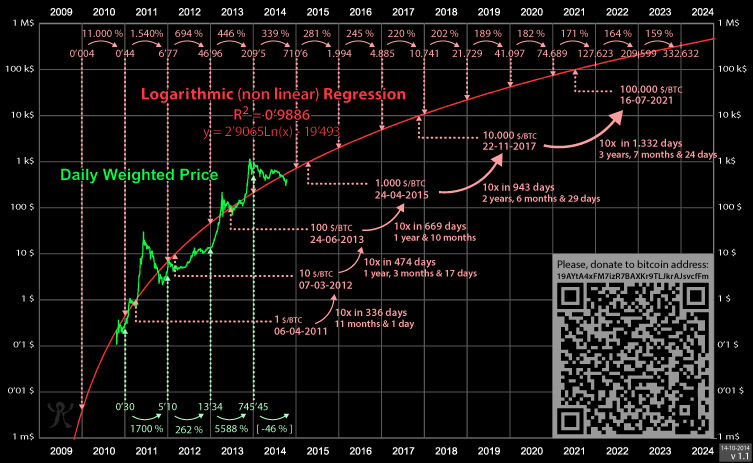
And he even says that if you flatten the predictive red curve he drew, you can obtain the spread between the current price and the estimated value. In other words, the red line represents the center of the rainbow.

Here’s the color legend:
- Dark blue: buy a lot
- Light blue: buy
- Dark green: accumulate gradually
- Light green: still cheap, can buy
- Yellow: hodl
- Light orange: is this a bubble?
- Dark orange: FOMO intensifies
- Light red: sell, seriously, SELL!
- Dark red: maximum bubble, market is crazy!
And if we follow the chart, at this moment we are in the accumulation zone, heading towards $100,000 per Bitcoin:
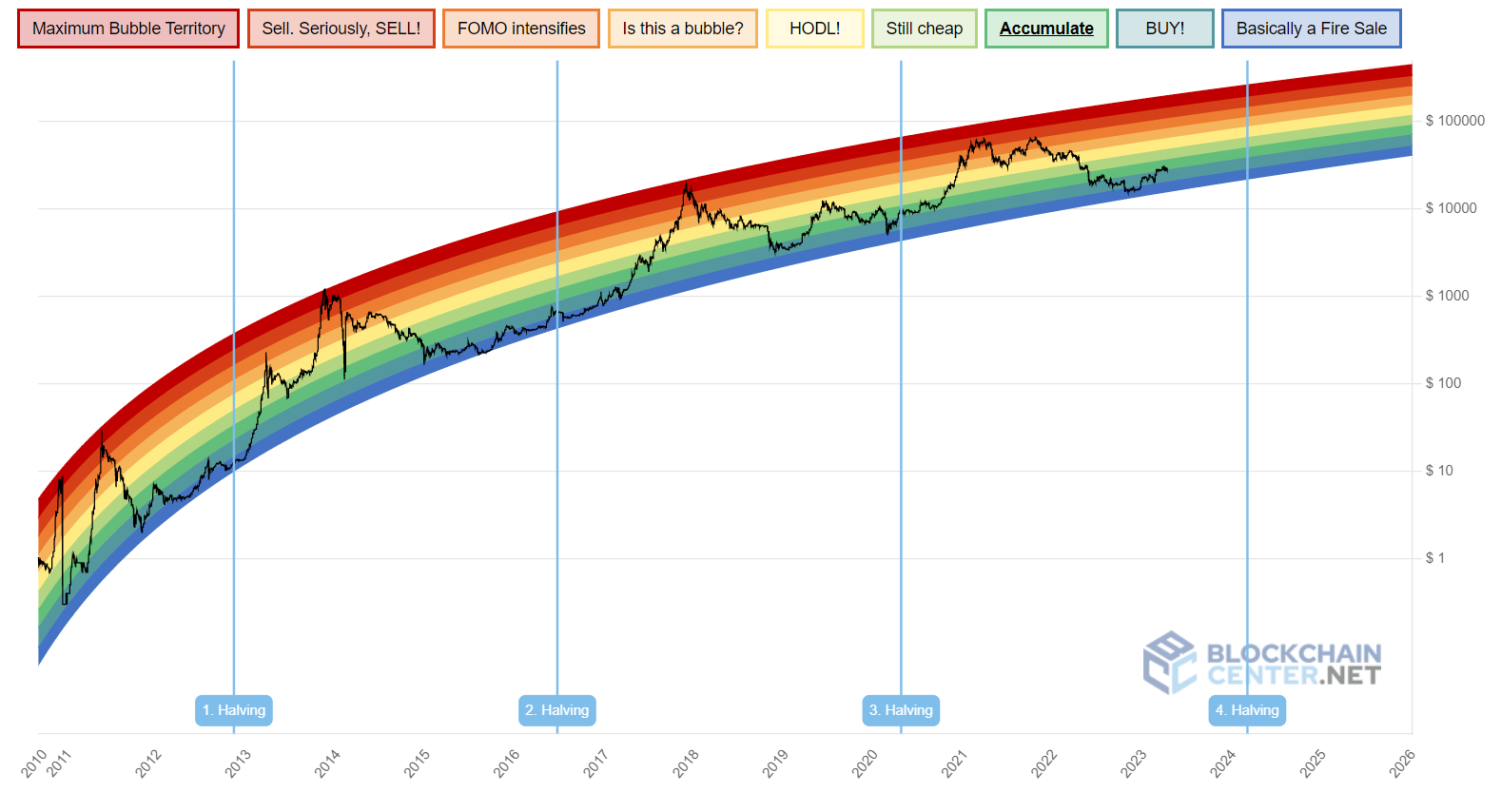
Despite being a fun analysis, this chart is not an investment recommendation.
On the website where you can track the rainbow chart, there’s a disclaimer:
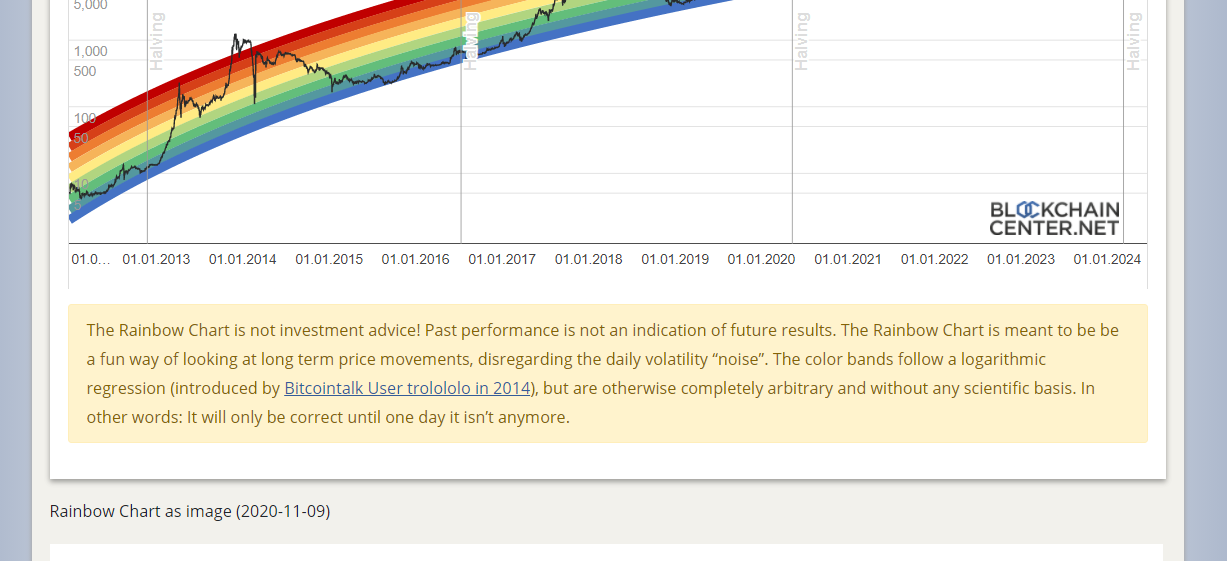
Rainbow chart message
The Rainbow Chart is not investment advice!
Past performance is not an indication of future results. The Rainbow Chart is meant to be a fun way to observe long-term price movements, disregarding the daily ‘noise’ of volatility.
The color bands follow a logarithmic regression (introduced by Bitcointalk user Trolololo in 2014), but they are completely arbitrary and without any scientific basis.
In other words: it will be correct until one day it’s not.
Stock To Flow Theory
The next predictive model for Bitcoin is STOCK-TO-FLOW or S2F, created by an anonymous person known as PlanB. It predicts the long-term trend of Bitcoin’s value based on its scarcity.
Since Bitcoin has a limited number of units that will be created, 21 million, and the supply of new units keeps decreasing over time, scarcity is the main factor driving the price.
The model references scarce metals that are also considered stores of value by the market:
- Gold;
- Silver.
The study suggests that Bitcoin is the first scarce digital object the world has ever seen, scarce like silver and gold, and can be sent via the internet, radio, satellite, etc.
This digital scarcity certainly has value. But how much? This theory attempts to quantify scarcity to model Bitcoin’s value.
In this model, halvings are crucial, as they cause the growth rate of supply to be staggered and not uniform, as shown in the image below, where the price rises as the supply of new Bitcoins reduces in a staggered manner.

According to the Stock To Flow chart, bitcoin will be worth around $500.000 per unit by 2026:
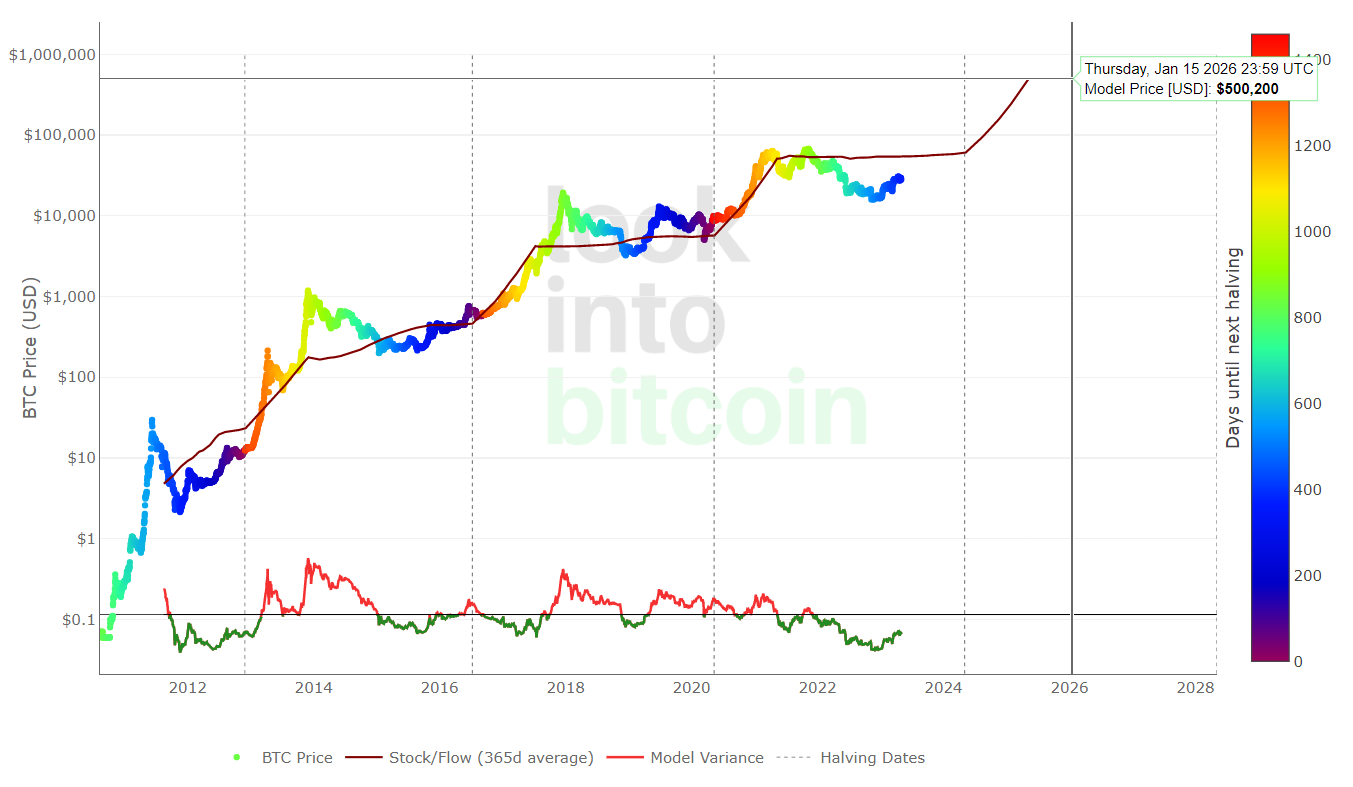
The theory’s creator also says
“People ask me where all the money needed for a $1 trillion market value of Bitcoin would come from? My answer: silver, gold, countries with negative interest rates (Europe, Japan, US soon), countries with predatory governments (Venezuela, China, Iran, Turkey, etc.), billionaires and millionaires hedging against quantitative easing (QE) and institutional investors discovering the best-performing asset of the last 10 years.”
Critiques of this model argue that gold’s price has not appreciated solely due to its scarcity but also its history as a store of value and utility, and in this sense, Bitcoin is still too young to be compared to gold. The second critique is that this model uses a linear chart instead of a logarithmic one, which could distort the data.
There’s Still Time to Start
Although it’s fun to make calculations and follow price theories, only time will tell which of these predictions comes closest to Bitcoin’s future price. But the great news is that if any of these calculations are correct, Bitcoin still has much room to appreciate.
We’re currently in a bear market, which is very helpful for those who want to start accumulating Bitcoin with a long-term vision. This is a unique moment, so don’t wait to start until everything is obvious.
We’ve created Bitcoin Starter as a step-by-step guide to help you put a long-term Bitcoin investment plan into practice to achieve your financial sovereignty:
➡️ Over 50 theoretical and practical lessons
➡️ Our Parabolic Portfolio investment method
➡️ Altcoin X-ray revealing the reality behind “promising projects”
➡️ Direct support from our team via email
This is our four years of study and market experience condensed into 20 hours of lessons where we share everything we know so that you can invest safely in Bitcoin, take advantage of the appreciation in the upcoming cycles, and build your generational wealth.
Stack sats and opt out!
Share on your social networks:

One of the leading Bitcoin educators in Brazil and the founder of Area Bitcoin, one of the largest Bitcoin schools in the world. She has participated in Bitcoin and Lightning developer seminars by Chaincode (NY) and is a regular speaker at Bitcoin conferences around the world, including Adopting Bitcoin, Satsconf, Bitcoin Atlantis, Surfin Bitcoin, and more.
Did you like this article? Consider buying us a cup of coffee so that we can keep writing new content! ☕







